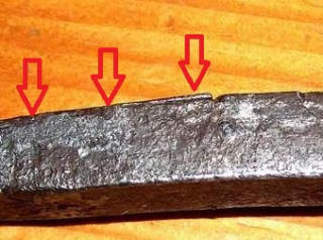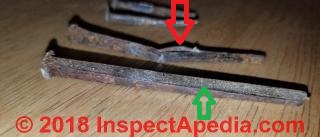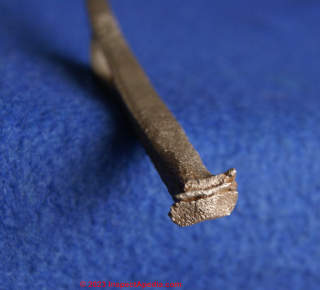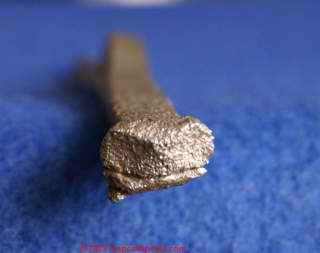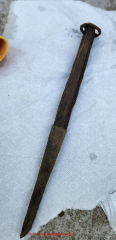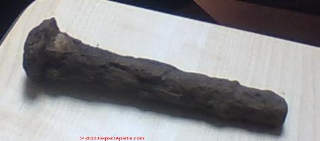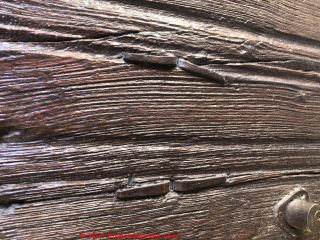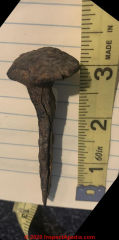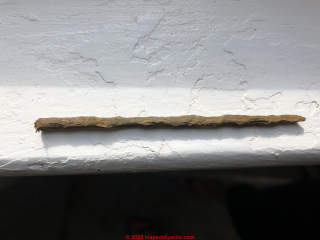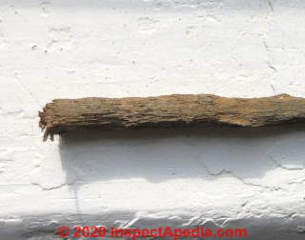 Splits in Iron Nails
Splits in Iron Nails
Iron Fiber Direction Can Help Tell Nail Age
- POST a QUESTION or COMMENT about using a split in a nail to help determine its age
Splits in a nail probably indicate direction of its iron fibers - either parallel to or across the shank. The direction of the split, therefore the iron fibres, give a clue as to the nail's age.
This article series describes antique and modern cut nails focusing on tree nails, wrought nails, and cut nails used in wood frame construction or interior finishing or carpentry work. It includes useful dates for the manufacture of different nail types. Easy questions help form a guess at the plausible age of various types of antique & modern nails.
InspectAPedia tolerates no conflicts of interest. We have no relationship with advertisers, products, or services discussed at this website.
- Daniel Friedman, Publisher/Editor/Author - See WHO ARE WE?
Guess the Age of Nails & Building Hardware with Key Questions
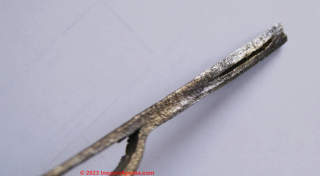 A physical examination of old or antique nails and fasteners and other building hardware combined with questions about the country, city, and building or other location where the nails were found can offer clues to the probable age and original purpose of the old nail or spike.
A physical examination of old or antique nails and fasteners and other building hardware combined with questions about the country, city, and building or other location where the nails were found can offer clues to the probable age and original purpose of the old nail or spike.
Here we discuss cracks or splits in early nails, their cause and significance and their use in estimating the age of the nail.
Because these cut nails were manufactured at a lower temperature than hand-forged nails, the fabricating process, especially the nail heading step, could cause splits or cracks along the shank of the nail - the direction of the iron fibers. - (Wells 1998, Ciccone 2022)
[Click to enlarge any image]
Our images of the end of an early machine-cut nail at the top of this page as well as in closer-view just above, provided courtesy of InspectApedia reader CM in the U.K. illustrates, by the separation of the nail's shank, compelling evidence that the iron fibers run parallel to the shank length.
Antique Nail & Spike Age Inspection Points
These primary inspection points use
- Nail / Spike Location
- Age of nail's surrounding materials - contextual information
- Nail Application or Use
- Color, Condition of & Marks on Wood or Other Materials Surrounding the Nail
- Physical properties of the nail or spike itself can give nail age & age of building or furniture or tools
such as nail size (length, diameter), shank, point, head and tip shape and features - Nail head details and burrs on the shank left by the nail cutting process and other clues to nail age are discussed separately and depth at
- Special nail condition such as the splits or separation in the nail shank as shown on this page.
Splits in a rusted or damaged nail shank illustrate the direction of iron fibres in the iron and can indicate the nail age.
Across-shank = before 1830;
Parallel to shank = machine-made cut nail, probably after 1830.
These and other clues to nail age are discussed separately and in depth at
This article's focus on the presence of a split(s) in a nail's shank, one of the inspection points noted above, gives important clues as to its age.
Nail Age & History vs Appearance of Splits Along Nail Shank
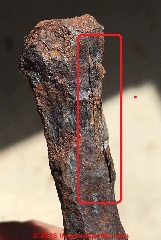 Iron Fibers that are oriented across the nail shank = before 1830.
Iron Fibers that are oriented across the nail shank = before 1830.
Iron fibers that are oriented parallel to nail shank = machine-made cut nail, in the U.S. that's roughly after 1830.
Illustration: splits in this antique nail probably indicate direction of its iron fibres - parallel to the shank dimension - discussed in detail below.
When nails were cut by hand operated machines (later wind or water powered machines) the iron blank from which the nails were cut would be oriented such that the iron fibers ran parallel to the nail shank.
This detail was significant in that when the iron fibers ran across the shank of a nail, trying to clinch or bend over the protruding end of a nail tip as it extended through wood would generally cause the nail tip to break off, denying the additional withdrawal strength that nail tip clinching could afford.
Informed by Phillips' "Revised Chronology of Cut Nails in New England: Wrought and Cut Nail Characteristics", (1993) cited in detail
at NAILS & HARDWARE, AGE RESEARCH
- 17th through early 19th centuries, Hand-Wrought Nails
Nail shank characteristics: no burrs (found on cut nails), all 4 sides taper, iron grains run in the direction of the nail shank or longitudinally, nail shank rectangle is irregular in cross-section.
Watch out: modern reproductions of hand-wrought nails are still provided (2021) by companies such as the Tremont nail company.
- 1790 - 1820: First Cut Nails in North America
Cut nail shank characteristics: regular in cross-section.
Phillips noted that earliest cut nails are parallelogram in cross-section. iron grains run across the nail shank; two sides of the nail will be parallel, the other two sides will taper.
This is because the nail was cut from a pre-flattened blank. Burrs along the shank appear on diagonally opposite edges.
- Prior to 1830 Cut Nails
As described at 1790 - 1820 above, burrs may be on opposing sides of the nail shank depending on the cutting machine
Cut nail shank characteristics: irregular width indicates prior to 1830.
In North America before the 1830s, the iron fibers in machine cut nails ran across the nail shank, causing the nail to break off if the user tried to clinch it's protruding end.
Successfully bent-over or clinched cut nails = manufactured by machine after 1830.
- After 1810 - ca 1840 Transitional Machine Cut Nail Properties
Or by Phillips (1993), "Transitional Machine-Cut Nails, Post 1810 - c. 1840, possibly as early as 1807"
Nail shank characteristics: regular rectangle in cross-section, iron grains run across the nail shank (horizontal in some texts), so attempts to bend over or clinch the tip will break off the nail.
Two sides parallel, other sides tapered (again, because the nail was cut from a flat blank).
- After c 1835 - ca. 1890 "Modern" Machine-Cut Nails (in North America) - expect any along the shank splits to be in these nails
Nail shank characteristics: regular rectangle in cross section,
iron grains run parallel to shank, along the direction of the nail shank or long-ways (nail can be bent over or clinched without breaking),
2 shank sides taper and other 2 sides are parallel (cut from a flat blank).
When splits in the nail run parallel to the shank, in a nail made in North America, the nail is likely to have been made after 1830.
Cutting machine leaves burrs on two edges of the same side of the nail (as the blank was not flipped over to make a second side cut), i.e. the cut nail burrs show that cuts were from same side
Shank width is uniform / uniformly-tapered on both sides except that
Shank bevel under the head may extend 1/3 or more down the length of the shank
Photo below: large iron spike found near Elmira, Ontario by Vern M shows laminar splitting along the length of the nail shank, giving an earliest date that some sources put at 1830.
[Click to enlarge any image]
Our photo below illustrates these cut nail features including splits along the shank length indicating the direction of the iron fibers.
Antique cut nails provided by an InspectApedia.com reader: two cutting/stamping burrs appear on the same side of the nail suggest the nail may have been made after 1840.
More help: NAILS, AGE & HISTORY - topic home where we give a chronology of types of nails from 300 B.C. to the present. Be sure you also review that article when looking at your own found nail or spike.
Causes of Cold Shuts & of Cracks & Splits in Nails
The following excerpts offering details of splits and cracks in the shank or head of antique nails are from Tom Wells' Nail Chronology: The Use of Technologically Derived Features, Historical Archaeology, 1998,32(2):78-99 cited just below.
Heading was done cold or at a low heat, putting great stress on the iron, often resulting in small cracks that run with the grain on the face side of the head. The cracks result from the iron separating along the grain under the force of heading. It is common to find long cracks on the cut faces of all iron cut nails, indicating that the iron was poorly consolidated. As iron producers adopted better iron making techniques, the quality of wrought iron improved so that such cracks are less often seen in nails made after the I840s. - Wells p. 86
To determine if the nail is iron or steel the distinctive characteristics of iron are important; these include grain and possibly a poorly consolidated structure such as cold shuts and cracks described below. The absence of the typical characteristics of iron probably indicates steel. The transition from the use of iron to steel in the nail industry was not immediate, having begun in the mid-1880s and continued into the 1890s. - Wells p. 91
Cracks and cold shuts are characteristic of wrought iron. Cracks result from the fibers of unconsolidated iron opening as the metal is worked. The cracks occur along the grain, where the slag prevented a perfect union of the metal.
On cross-grained nails the crack will run across the face, while on grain-in-line nails the cracks will run length-wise on the face. On the cut face of both kinds of nails there may be a crack, or even separation, running length-wise down the shaft.
The heads of either kind can be cracked across the top in the direction of the cut faces. Cold shuts are unconsolidated metal folded against the body of the stock. There are numerous causes of cold shuts, but for the purposes of defining nails, they occur on handforged nails when the burr is hammered flat against the nail shaft. - Wells p. 93
Source: Wells, Tom, NAIL CHRONOLOGY: THE USE OF TECHNOLOGICALLY DERIVED FEATURES [PDF], Historical Archaeology, Vol. 32, No. 2 (1998), pp. 78-99, retrieved 2019/01/08, original source (stable URL) http://www.jstor.org/stable/25616605 .
Note: Society for Historical Archaeology is collaborating with JSTOR to digitize, preserve and extend access to Historical Archaeology.
...
Reader Comments, Questions & Answers About The Article Above
Below you will find questions and answers previously posted on this page at its page bottom reader comment box.
Reader Q&A - also see RECOMMENDED ARTICLES & FAQs
On 2023-03-15 by InspectApedia Editor - details and potential cause of the bulged separated laminate from a split nail from 1830s UK shipbuilder
@Colin,
 I suspect that the split we see in that interesting nail was caused by either
I suspect that the split we see in that interesting nail was caused by either
- pressure from exfoliating iron flakes (but there's just not a lot of rust there to produce enough volume)
- pressure from frost as a combination of wet wood fibres and ice froze repeatedly in the opening in the split of that nail.
- if the split had already formed when the nail was re-used as you posit, the driving force might have widened the opening as the nail was driven into the wood, perhaps later widened by the forces I guessed-at above.
About the nail being "bent" - it's common for nails to bend as they are driven into wood, especially harder woods. As it is being driven, the nail tip wants to follow the path of least resistance, such as through summer-wood and around knots in the timber or board into which it's directed.
A nail, even a very straight one, if extracted by pulling, will also usually be bent, but Colin's description suggests that the nail was never pulled.
Colin: we'd be grateful for more photos of this nail, high resolution, that you can post or you can send to us by email to our editor - found by the page top or bottom CONTACT link.
Do include a ruler along the nail in one photo to give a measurement of scale.
Note for other readers: we think Colin's nail from a building in Sunderland refers to the Sunderland, a coastal city located in the UK near Newcastle upon Tyne. Sunderland's history as a 12th century fishing village that grew to a seaport trading in coal and salt.
As a result of Colin's photos and this discussion, we created this new page on splits in iron nails - a topic that we also describe at our NAIL AGE DETERMINATION KEY - and mention elsewhere in this article series.
On 2023-03-13 by Colin
@InspectApedia Editor , Many thanks for your reply. This type of nail ties in with the construction of the building (1830's) therefore it is presumed that the nail was new and not re-cycled from an earlier wooden ship. Presumably the UK practice of machine-making of nails would have closely followed American practice.
The nail would have been driven in straight therefore have you any thoughts on why the fibres would have split whilst in the timber and, more especially, distorted to such a degree?
All of the rust has been removed from the nail and the fibres and splits are consequentely more pronounced. If you would like photographs of the cleaned nail please let me know. I can be contacted at:- colinmeddes@tiscali.co.uk.
On 2023-03-12 by InspectApedia Editor - Sunderland UK shipbuilding split nail
@Colin,
Thanks that's a great photo of an older nail that shows, by the nature of its split, that the direction of iron fibers in its shank ran parallel to the shank itself.
That feature is discussed at SPLITS IN IRON NAILS - the article above on this page
When the iron fibers run parallel to the shank, in a nail made in North America, the nail is likely to have been made after 1830.
The roughly-rectangular shape of the nail shank, the details of its point, and the nail head are also discussed in the nail age determination key.
(this reader discussion and photos were originally posted at AGE OF NAILS - FAQs 3)
On 2023-03-11 by Colin
The nail was found when de-nailing a baulk of timber during the restoration of a 1820's building in Sunderland. The original owner was a shipbuilder therefore the baulk may have come from an earlier wooden ship.
The nail is 125mm long and made of 3 fibres of wrought iron and had to be extracted by removing the surrounding timber. All the other nails came out straight.
The distortion affects 2 fibres which have elongated by 3.5mm but show no signs of distress. Presumably the distortion occurred post-insertion. The nail is as extracted and has not been straightened. Any ideas on the distortion?
Below we see the entire nail; note that the split extends through more than half of the nail shank.
Below: additional photos of Colin's nail provide more details of the nail's head, tip, shank. Also the the same nail along with a ruler for size, at the top of this page.
Below are detals of the head on this same Sunderland split shank nail.
...
See complete details about this nail, courtesy of Mr. Meddes, in
- Meddes, Colin, THE HUTCHINSON'S BUILDINGS NAIL, A short report into the probable cause of the deformity to the nail [PDF] (April 2023),
Introduction:
Whilst de-nailing a timber baulk for re-use during the recent restoration of Hutchinson’s Buildings in Sunderland, one particular nail proved difficult to extract. It was only by destroying the surrounding timber that extraction became possible.
The nail thus removed was found to have an un-usual and interesting distortion which could not be readily explained.
Advice was consequently sought from various organisations and individuals with experience in the field of restoration plus academics with historical knowledge of early timber fastenings as to what may have caused the distortion.
Their findings and observations have been condensed into this short report which is aimed at the layperson with a general interest in the nail referred to therein. It is not, therefore, to be regarded as a technical publication.
Note; Sunderland is a U.K. port city in Tyne and Wear, in Northeast England, in the historic county of Durham. The area's earliest inhabitants were stone-age hunter-gatherers. "Modern" occupants date from 674 and later Roman occupants. - Ed.
Excerpt:
The building in which the nail was found is known as Hutchinson’s Buildings which occupies the site comprising 1 & 1a Bridge Street and 101 to 109 High Street West in the city of Sunderland.
On 2022-07-13 by InspectApedia-911 (mod)
@Tina Dykes,
Notice that the splits in the shank of the nail run parallel to the shank length and compare that detail in the nail age determination key.
On 2022-07-12 by Tina Dykes
found while magnet fishing. 13 1/4 inches long.
On 2022-05-12 by Inspectapedia Com Moderator - split in nail is parallel to shank
@sophia,
It's worth noting the direction of that split in your rusty iron spike or nail: parallel to the shank. We cite that detail in the article above on this page.
On 2022-05-12 by sophia
we found a old nail on our school grounds whilst digging a hole.we think its from the early 1900s but we're not sure
On 2021-09-04 by inspectapedia.com.moderator (mod) - age of "split nails" or clinched nails or bent-over nails
@Eleanor,
In the article above you we should be sure to read the section on the direction of iron fibers as a break point in aging Nails
Clinched Nails could not be bent over without breaking until iron fibers were made to run parallel to the length of the nail.
On 2021-09-04 by Eleanor - split nails age
I am interested in the age of these ‘split nails’. It is an old oak door and at attaching the bolt on the other side of the door.
On 2020-12-22 - by (mod) -
Nice Photo, Charles.
Your 2nd nail from the top has what looks like a vertical split - along the long axis of the nail.
Above on this page, you'll see that that detail along with others looking closely at cut marks, burrs, head details, can give a rough "earliest-date" and other information about these nails.
On 2020-12-22 by Charles Hite Jr
I have some old nails found in an old cabin boards in West Virginia and trying to identify their manufacture or possible age.
If I need to take more photos to show more details, please advise. chitejr@aol.com
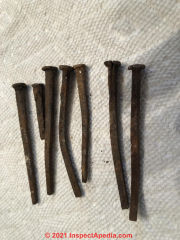
On 2020-09-16 - by (mod) -
Liz, in the article above on this page, review our comments about splits or delaminations in the long direction along the nail shank: such a split is often characteristic of the effort to align the fibres of iron running down the length of the nail - discussed in our description of nails made after 1830 -
On 2020-09-16 by Liz
Found an old nail on a beach on the eastern shore of USA. Wondering about age and any info.
On 2020-07-15 - by (mod) - vertical splits in iron nail, parallel to shank, may help guess age
 Alex
- regarding your nail photo shown here:
Alex
- regarding your nail photo shown here:
Sure the nail could have been used on a boat or ship, given its location.
It's so rusted that there is not much to see, but I did notice the vertical split in the iron tip of the nail, giving it a dating clue as you'll find at
NAIL AGE DETERMINATION KEY
There we state
In North America before the 1830s the iron fibres in machine cut nails ran across the nail shank, causing the nail to break off if the user tried to clinch it's protruding end.
I don't have the same historical detail on nail manufacture in the UK, perhaps you can help me look for that. In general, a split along the nail shank makes it "newer".
I think we see that the nail shank is NOT rounded - so it's not a "wire" nail. The earliest "wire" made nails in the U.K. showed up from Belgium in the 1960s, possibly 1863. So we don't have that clue.
You might also want to join me in taking a look at
- Ryzewki, Krysta and Robert Gordon, "HISTORICAL NAIL-MAKING TECHNIQUES REVEALED IN METAL STRUCTURE " [PDF] Historical Metallurgy 42(1) (Jan 2008 pp 50-6), retrieved 2020/07/15, original source: www.academia.edu/1308787/Historical_nail-making_techniques_revealed_in_metal_structure?auto=download
Figure 3 in that really interesting nail metallurgy paper shows slag fibres and other details running parallel to the nail shank but I could not immediately translate that into a date for nail making in the U.K. nor would it map the intended use of the fastener in your photo.
I'm reading further.
On 2020-07-15 by Alex
[Photo of nail above] Found on Eype beach Dorset. Is this a nail? Could this have a maritime origin?
Thanks
Question: Canadian spike: estimated age 1830 + shows laminar splits along spike or nail shank
I have a spike that was taken out of the old farm house where I was born and raised . It was located 3.5 miles east of Elmira Ontario Canada. A date was inscribed into the basement wall during construction however it was not done clearly.
We cannot determine if it is 1803 or 1863. I was hoping that you may be able to tell when this house was built by this spike.
There is a very slight split in the metal about one half of the way down the shank.
The head is quite unique as it appears to have been crimped down in the corners to create a square on the top in a different direction than the base of the head. Any help you could provide would be appreciated. - (Mar 24, 2020) Vern M
Reply:
Thanks for the interesting nail photo, Vern. I'd like to see a sharp closeup of the split in the nail.
As I mentioned about a different nail in photos on this page, the fact that the delaminating or split in this nail run lengthwise (parallel to the nail shank) suggest that the nail was of iron whose fibers ran lengthwise, making the nail one probably made after the late 1830s.
For these nails, because it appears that the two cutting/stamping burrs appear on the same side of the nail suggest the nail may have been made after 1840.
- 1830 - present: Modern machine-cut nails that resemble nails still used today appeared in North America in the late 1830s.
Cut nails were cut from opposing sides, improved or "perfected" machine made nail heads.
The presence of machine cut nails is a reasonable indicator that a building was constructed (or site occupied) in the 1830's or later. (Adams 2002).
Cut nails made after the late 1830s will typically have:
- nail heads that are uniform and are convex on both sides
- uniformly-tapered shank width or sides
- cutting machine burrs both on the same side of the nail
- were made of iron whose fibres ran lengthwise [see Ashley's nail iron fiber and Tony's railroad spike rusty iron fibres in photos above], so these nails can be clinched without breaking off
- will differ little from modern (2019) cut nails
Photos above: fragments of an iron nail appearing to show iron fibers running lengthwise along the shaft of the nail, courtesy of reader Ashley who wrote:
Can you give me your opinion on these 2 pieces I found. We live about 700 ft from one of the first North American settlements circa 1630’s. - (Apr 12, 2020) Ashley
The laminar splits near the nail head suggest old iron, likely to have been forged as early as 1830. - Mod
...
Continue reading at NAIL AGE DETERMINATION KEY or select a topic from the closely-related articles below, or see the complete ARTICLE INDEX.
Or see these
Recommended Articles
- AGE of a BUILDING, HOW to DETERMINE - home
- NAILS, AGE & HISTORY - home
- HORSESHOE & HORSESHOE NAIL AGE
- NAIL & HARDWARE, AGE RESEARCH
- NAIL & HARDWARE CLEAN-UP
- NAIL AGE DETERMINATION KEY - use this key to guess at the age of your nail or spike
- NAIL ID & AGE: CUT NAILS
- NAIL ID & AGE: HAND FORGED NAILS
- NAILS in BARTER & TRADE
- NAIL SPLITS & CRACKS vs AGE
- NAIL TYPE, ANTIQUE, IDENTIFICATION KEY
- RAILROAD SPIKES
- RAILROAD SPIKE AGE - CONTEXTUAL CLUES
- SAW & AXE CUTS, TOOL MARKS, AGE
Suggested citation for this web page
NAIL SPLITS & CRACKS vs AGE at InspectApedia.com - online encyclopedia of building & environmental inspection, testing, diagnosis, repair, & problem prevention advice.
Or see this
INDEX to RELATED ARTICLES: ARTICLE INDEX to BUILDING AGE
Or use the SEARCH BOX found below to Ask a Question or Search InspectApedia
Ask a Question or Search InspectApedia
Try the search box just below, or if you prefer, post a question or comment in the Comments box below and we will respond promptly.
Search the InspectApedia website
Note: appearance of your Comment below may be delayed: if your comment contains an image, photograph, web link, or text that looks to the software as if it might be a web link, your posting will appear after it has been approved by a moderator. Apologies for the delay.
Only one image can be added per comment but you can post as many comments, and therefore images, as you like.
You will not receive a notification when a response to your question has been posted.
Please bookmark this page to make it easy for you to check back for our response.
IF above you see "Comment Form is loading comments..." then COMMENT BOX - countable.ca / bawkbox.com IS NOT WORKING.
In any case you are welcome to send an email directly to us at InspectApedia.com at editor@inspectApedia.com
We'll reply to you directly. Please help us help you by noting, in your email, the URL of the InspectApedia page where you wanted to comment.
Citations & References
In addition to any citations in the article above, a full list is available on request.
- In addition to citations & references found in this article, see the research citations given at the end of the related articles found at our suggested
CONTINUE READING or RECOMMENDED ARTICLES.
- Carson, Dunlop & Associates Ltd., 120 Carlton Street Suite 407, Toronto ON M5A 4K2. Tel: (416) 964-9415 1-800-268-7070 Email: info@carsondunlop.com. Alan Carson is a past president of ASHI, the American Society of Home Inspectors.
Thanks to Alan Carson and Bob Dunlop, for permission for InspectAPedia to use text excerpts from The HOME REFERENCE BOOK - the Encyclopedia of Homes and to use illustrations from The ILLUSTRATED HOME .
Carson Dunlop Associates provides extensive home inspection education and report writing material. In gratitude we provide links to tsome Carson Dunlop Associates products and services.


